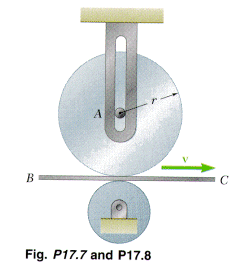
17.7 (Rigid Body Work Energy Equation)
Disk A is of constant thickness and is originally at rest. It is then allowed to fall in the slot and come into contact with the moving belt BC. (Belt BC's velocity is v, a constant.) Once the disk comes in contact with the belt, there is a period of slipping while the disk's outer edge velocity comes up to the belt's speed. During this period of slipping, there is a constant frictional force between the belt and the disk. The coefficient of friction between the belt and disk A is m. Write an expression (for q, in terms of v, r, and m) giving the number of revolutions of the disk necessary to bring the disk up to a constant angular velocity, w.

Comments/Hints:
1. The only work on the disk A is the work of the friction force, F, and
it acts over a distance equal to the arc length of the periphery of the disk
A. So, F = mmg, and arc length = rq.
2. Calculate IA = 1/2mr2.
3. Use the work-energy equation: T1 + SU1-2
= T2
4. Kinetic energy stored in a body in rotation is T = 1/2·IG·w2.
5. You should get q = v2/(4rmg)
radians = v2/(8prmg)
revolutions.